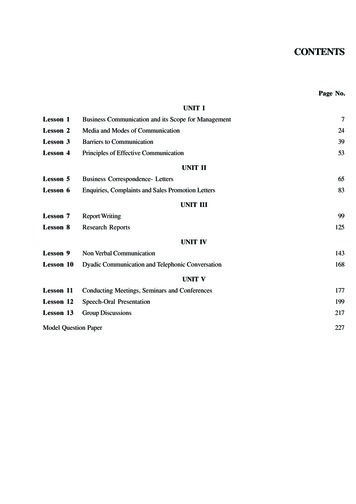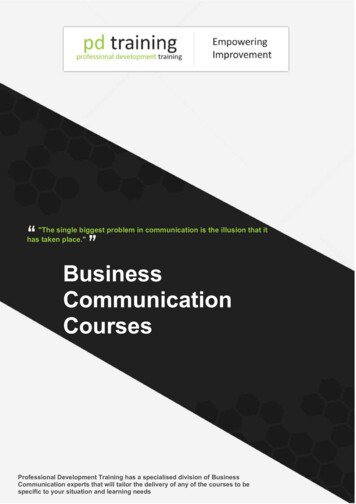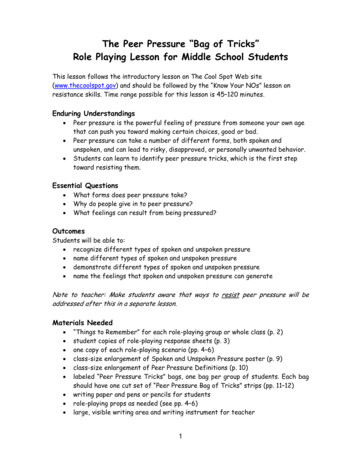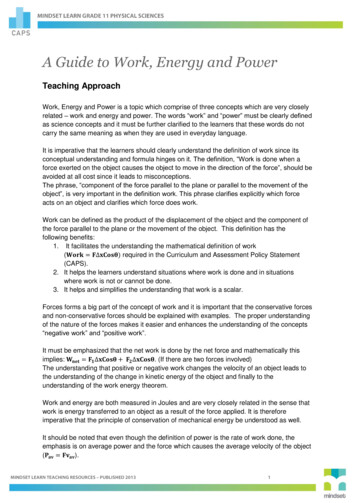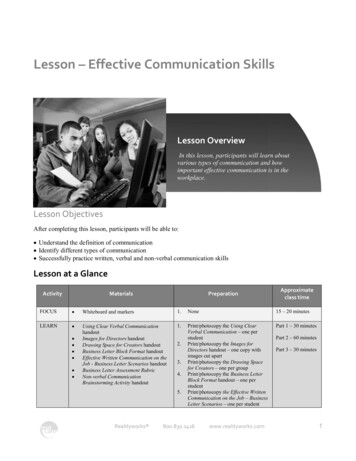
Transcription
Lesson – Effective Communication SkillsLesson OverviewIn this lesson, participants will learn aboutvarious types of communication and howimportant effective communication is in theworkplace.Lesson ObjectivesAfter completing this lesson, participants will be able to: Understand the definition of communication Identify different types of communication Successfully practice written, verbal and non-verbal communication skillsLesson at a GlanceActivityMaterialsPreparationApproximateclass timeFOCUS Whiteboard and markers1.None15 – 20 minutesLEARN Using Clear Verbal CommunicationhandoutImages for Directors handoutDrawing Space for Creators handoutBusiness Letter Block Format handoutEffective Written Communication on theJob - Business Letter Scenarios handoutBusiness Letter Assessment RubricNon-verbal CommunicationBrainstorming Activity handout1.Print/photocopy the Using ClearVerbal Communication – one perstudentPrint/photocopy the Images forDirectors handout – one copy withimages cut apartPrint/photocopy the Drawing Spacefor Creators – one per groupPrint/photocopy the Business LetterBlock Format handout – one perstudentPrint/photocopy the Effective WrittenCommunication on the Job – BusinessLetter Scenarios – one per studentPart 1 – 30 minutes 2.3.4.5.Realityworks 800.830.1416www.realityworks.comPart 2 – 60 minutesPart 3 – 30 minutes1
6.7.REVIEW 1.NoneRealityworks Print/Photocopy the Business LetterAssessment Rubric – one per studentfor the instructor assessmentPrint/photocopy the Non-verbalCommunication BrainstormingActivity handout – one per groupNone800.830.141610 minuteswww.realityworks.com2
Lesson – Effective Communication SkillsFOCUS: Class Discussion 15 - 20 minutesPurpose:Good communication skills, both verbal andwritten, are important to have on the job. Thislesson will give students a chance evaluate effectivecommunication and how they can improve theirown communication skills.4. Tell students that good communication is a keyskill that employers need in the workplace.Now that they have identified a few ways theyare using and developing their communicationskills in school, discuss ways they may usecommunication skills in the workplace.5. Have each student choose one occupation (itcan be anything) and give one example of howcommunication is used in that position. (Seebelow for examples)Materials: Answering a questionWhite board and markerFacilitation Steps:Doctor – verbal communication explainingtreatment to a patient1. Begin by introducing the definition ofcommunication to the class. Communication isthe exchange of information between a senderand a receiver. Communication involvesspeaking, listening, reading and writing. To bean effective communicator you need to be clearand direct. Ask students what types ofcommunication occur. Some answers might bewritten, verbal or nonverbal.2. Divide the class into small groups of three orfour students. Assign a recorder to write downthe group answers to the following question:How do you use communication skills atschool?Give groups 5 minutes to brainstorm.3. Call the class back together and have eachrecorder share their groups answers. Are theresome that were on everyone’s list?Some responses might be: Talking in class Writing a report Making a class presentationRealityworks Journalist – writing an news article for amagazine or newspaperWait staff or server at a restaurant – verbalcommunication explaining daily specials to acustomerMarketing associate – writing a blog about anew product6. Now that students have an understanding ofwhat communication is and how it is used onthe job, ask each student to answer thefollowing question: Why are goodcommunication skills important in theworkplace? (Hint: Think about what canhappen when communication is poor.)7. Ask each student to share their answer to thequestion. Answers could include – so that tasksare carried out accurately, so customers get theinformation they need, to get things done in anefficient manner.800.830.1416www.realityworks.com3
Lesson – Effective Communication SkillsLEARN: Active Practice120 minutesthe job of each of the roles in the group. Makesure students understand what they are to do inthis exercise.Purpose:The purpose of this activity is to have participantsactively practice effective communication in aseries of different activities. To develop effectivecommunication skills, students need practice justlike any other skill.Materials: Images for Directors handoutDrawing Space for Creators handoutUsing Clear Verbal Communication handout one for each groupFacilitation Steps:Activity 1 – Using Clear Verbal Communication(30 minutes)1. Divide the class into groups of four. If you donot have an even number of students, add oneextra to various groups, making no group morethan five.2. Assign each person in the group one of thefollowing roles: DirectorManagerCreatorObserver(s)4. Give each Director the picture of their object.Ensure no other team members can see it. Giveeach Creator a blank sheet of paper and makesure they have a pencil and/or eraser. Observersshould have paper for note taking. The Creatorsare to sit in the opposite corner of the classroomaway from the Directors. They should not beable to hear the conversation between theDirector and the Manager. Observers should befree to move where they need to in order towatch each step of the activity.5. Have each group follow the written instructionson the handout.6. Give each group five to ten minutes to completethe activity. When the time is up, call the classback together. Have each group share theoriginal picture of the Director’s object and thefinal product of the Creator. While comparingthe before and after results, have the Observersshare what worked, what didn’t and howeveryone reacted under pressure. Have themshare anything they believe could have donedifferently and perhaps in a clearer way. Thiswill provide a way for each group to reflect onhow successful their communication was as agroup.3. Hand out the Using Clear VerbalCommunication handout to each group. ReviewRealityworks 800.830.1416www.realityworks.com4
Using Clear Verbal Communication Activity1. Assign one person to perform each of the following roles in this activity. If you have more thanfour people, have two people act as observers. Director – Give clear verbal instructions to the Manager so that the Creator can make anexact copy of the original.Manager – Listen to the Director’s instructions and then go to the other part of the roomto where Creator is and pass on the instructions.Creator – Recreate the image from the verbal instructions given by the Manager.Observer(s) – Watch and make detailed notes about what worked, what didn’t and howeach person reacted under pressure.2. Instructions for activity:a. The Director is given a picture of an image and this person is the only one allowed to seethe picture.b. The Director gives instructions to the Manager, explaining what the image looks like sothat the Manager can give good instructions to the Creator. During this part of the activity,the Creator is located across the room so that they cannot see or hear the instructions asthe Director gives them to the Manager.c. The Manager then goes over to the Creator and verbally passes on the instructions fromthe Director as clearly as possible.d. The Creator is given the Drawing Space for Creators handout and attempts to draw theimage as instructed by the Manager.e. The Observer(s) silently watch the entire activity and make notes about what has workedwell, what has not worked well and how each person has performed under pressure.Write down suggestions for a different way to communicate the instructions if you believethere is a better way than observed.3. Compare the Director’s picture of the image with the end result.Realityworks 800.830.1416www.realityworks.com5
Images for DirectorsCut each of the following images apart and give one to each Director. Make sure thatthe Director is the only one to see the image in the group.Realityworks 800.830.1416www.realityworks.com6
Drawing Space for CreatorsDraw your image in the box provided below. Follow the instructions from the Manageras closely as possible. Good luck!Realityworks 800.830.1416www.realityworks.com7
Activity 2 – Writing a Business Letter (60minutes)1. Introduce business letters. Tell students that animportant skill in many job setting is to knowhow to write a proper business letter. One of theeasiest and most widely used business letterformats is called the Block Format.2. Give each student the Business Letter BlockFormat handout. Review the standard parts of abusiness letter with students: HeadingDateInside AddressSubjectSalutationBody ParagraphsClosing and SignatureEnclosureRealityworks 3. Give each student the Effective WrittenCommunication on the Job – BusinessLetter Scenarios. Students should chooseone of the scenarios on the handout andwrite a business letter to address thesituation. They should follow the blockstyle format.4. After each student has completed an initialdraft, each student should have another peeredit their initial business letter draft. Peereditors should follow the template andmake sure that each part is included in thedraft, along with spelling and grammarchecks.5. Have students prepare the final businessletter and turn it in as part of their grade forthis lesson. Use the attached BusinessLetter Assessment Rubric for yourconvenience.800.830.1416www.realityworks.com8
Effective Written Communication on theJob – Business Letter ScenariosChoose one of the following scenarios and write an appropriate and professionalbusiness letter. You can invent the name of the person you are writing to, and theaddress and/or business name if needed.Scenario A: You work in the customer service department for Walmart. You receive acomplaint regarding a customer’s experience in the electronics department of a localstore. The customer was felt that they were disrespected.Scenario B: You work in a sporting goods store. A customer has written to you asking ifyou have a product in your store called the Fitbit. Your store does carry it along withother competitive products.Scenario C: You work in the marketing department for a cell phone company. Youwere recently approached in a phone call from an advertising firm asking if you wouldlike to purchase pens with your company’s logo on it from them.Scenario D: You are the Human Resources director at a large law firm. You need tosend a letter to a candidate who interviewed but did not get the job.Scenario E: You are a fifth grade teacher at Heritage Elementary School. You need towrite a letter to your district superintendent informing her about an upcomingfundraiser you are doing to raise money for a field trip to Washington, D.C.Scenario F: You are a manager at a local fast food restaurant. A customer recentlycontacted you via email to tell you that they found a piece of plastic in a hamburger.They are not happy about it and are threatening to sue.Realityworks 800.830.1416www.realityworks.com9
Business Letter Block FormatWhen writing a business letter, follow the format below.Heading – Your AddressNameStreet AddressCity, State, ZIPSkip 1 lineDateSkip 2 linesInside AddressMr./Mrs./Ms./Dr. Full name of RecipientJob Title of Recipient (if applicable)Name of the Company/Organization (if applicable)Street AddressCity, State. ZIPSkip 1 lineSubject:Skip 1 lineSalutation(Dear Ms./Mrs./Mr. and Last Name and a colon at the end)Skip 1 lineBody ParagraphsThis is the content of the letter. The paragraphs should be single spaced with one line skipped between eachparagraph.Body Paragraph 1Body Paragraph 2Body Paragraph 3Skip 1 lineClosing (Sincerely,)Skip 3 linesYour Typed Name (Handwritten Signature Above)Your Typed TitleSkip 1 lineEnclosureUse this if your letter includes another document other than the letter itself. If it is more than one, youwould type “Enclosures.”Realityworks 800.830.1416www.realityworks.com10
Business Letter Assessment RubricName:Realityworks 800.830.1416www.realityworks.com11
Activity 3 – Using Nonverbal Communication(30 minutes)1. Introduce nonverbal communicationPlay an abbreviated version of charades. Pickthree students and stand them at the front of theroom. Tell them to pretend that they are allabout to interview for a very important job andare waiting in a conference room for theinterviewer. Have the rest of the class commenton what the students' postures convey to them.Change the scenarios and choose three newstudents for each of the following or come upwith some of your own. Tell them they are justhanging out at home playing video games witha group of friends, or about to give apresentation to a group of 5000 conferenceattendees, or meeting their girlfriend orboyfriend's parents for the first time. Once youhave gone through various scenarios, haveeveryone share their opinions on how bodylanguage affects the way others see you.3. Gather the class back together and have eachgroup share some of items they brainstormedfor non-verbal communication. Next have eachgroup share one example for each category ofhow non-verbal communication may beperceived in the workplace.4. Here are three tips for improving your nonverbal communication skills:2. Form small groups of three to four students.Give them the Non-Verbal CommunicationBrainstorming Activity handout. Have smallgroups complete the handout brainstorming allof the non-verbal ways in which peoplecommunicate. Have students complete the restof the handout giving them about 10 minutes tocomplete the activity.Realityworks 800.830.1416-Body movements include using gestures toillustrate the message you are trying toconvey verbally. Use good eye contact andappropriate gestures. Have good postureand do not send mixed messages.-Voice quality also is important. It’s notalways what we say, but how we say it. Becareful of your tone when you speak. It hasthe power to take a simple sentence meantwith no ill intent and turn it into a chaoticmess. We also want to consider the volumeat which we speak.-Space and personal boundaries areespecially important in nonverbalcommunication. In order to communicateeffectively, we have to be aware of ourspace as well as the space of others.www.realityworks.com12
Non-verbal Communication BrainstormingActivityConsider the many non-verbal ways in which people communicate. As a group,brainstorm and list all of the different non-verbal ways you communicate thoughts andfeelings. (Example: crossed 19.20.Realityworks 800.830.1416www.realityworks.com13
Consider how your non-verbal communication may be perceived in a workplacesetting. What messages could you be sending to coworkers with your body language?Write a brief statement of how each of the following could be perceived by acoworker. (Example: Slouched posture may show you are not interested. Or minimaleye contact may signal lack of confidence)Eye contact:Facial expression:Posture:Handshake:Personal space:Vocal tone:Realityworks 800.830.1416www.realityworks.com14
Lesson – Effective Communication SkillsReview: The Importance of Clear Communication onthe Job10 minutesPurpose:The purpose of this discussion is to haveparticipants examine how they communicatedifferently when the setting or group of peoplechange. Everyone needs to learn to adjust theircommunication appropriately.Materials: NoneFacilitation Steps:1. Ask participants to consider how theycommunicate with their friends. Then ask howthey communicate with family members.Finally, ask how they are likely to communicatewith an employer at a job interview. Ask forvolunteers to describe each way ofcommunicating and interacting.2. Discuss the differences and similarities in thestudents’ responses. Ask: Why is each situation different? What are the expectations of each person? What would happen if you greeted yourfriends in the way you greeted an interviewer? What would happen if you greeted aninterviewer the same way you greet yourfriends?3. Knowing how to communicate with people inthe right context for a given situation is animportant skill, as there are often unspokenrules and standards that are just expected.Realityworks 800.830.1416www.realityworks.com15
Lesson – Effective Communication Skills FOCUS: Class Discussion 15 - 20 minutes Purpose: Good communication skills, both verbal and written, are important to have on the job. This lesson will give students a chance evaluate effective communication and how they can improve their own communication skills

